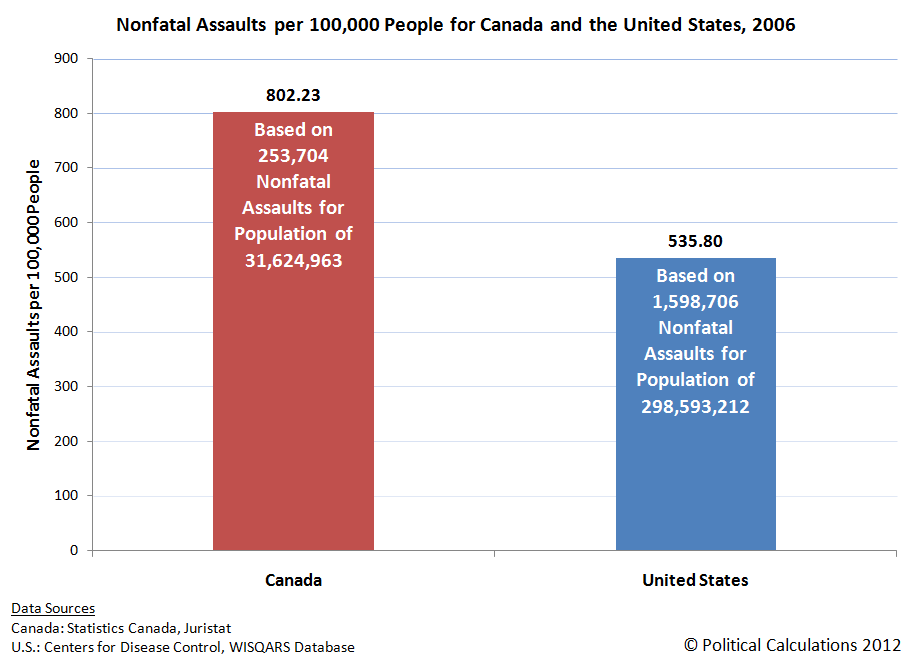
Violent Crime Rates Across Canada
Source: Wikipedia
Yesterday, we suggested that Canada's apparent reduction of 1 homicide victim per 100,000 people that might be attributed to Canada's more restrictive gun control laws as compared to the United States was perhaps overstated.
The reason why that may be the case is because Canadian homicide offenders, who are less able to acquire firearms than U.S. homicide offenders, instead substitute the homicide methods of stabbing and beating in committing their murders.
Unlike shooting, these methods of murder require far more physical energy and time on the part of the offenders to kill their victims. So much so that it is more likely that the victims of these kinds of assaults might be able to survive the effort to kill them than a shooting victim is able to survive being shot.
One consequence of this greater difficulty for offenders to kill their victims through these kinds of violent assaults is that Canadian homicide statistics will not fully reflect how close some of the victims who survived being assaulted this way may have come to actually being killed.
To get a better sense of that factor, we returned to Canadian crime statistics and the U.S. WISQARS non-fatal injury database to compare each nation's relative levels of nonsexual and nonfatal assaults. The raw numbers we found for both nations are presented in our first chart.
Update 31 December 2012: We've corrected the numbers in the chart below, which previously only showed the combined total of Level 2 and Level 3 assaults in Canada, but all nonfatal, nonsexual assaults in the United States - the corrected version below shows the correct total for all nonfatal, nonsexual assaults in Canada in 2006. We've edited the remaining text and charts in the post to correspond to the corrected total assault numbers for Canada.
We next calculated the nonfatal assault rate per each 100,000 people for each country's entire population.
Update 31 December 2012: The original version is here, which was based on Canada's total nonfatal, nonsexual assault totals with a different estimate of Canada's population.
Since the WISQARS nonfatal injury data cannot be broken down by U.S. racial and ethnicity classifications as the database's fatal injury data can, this is as far as we can take the analysis. However, it is far enough to draw the conclusion that Canadians are assaulted at far higher rates than are Americans.
Overall, in 2006, there were 56,706 253,704 nonsexual assaults in Canada, or 770.23 802.23 per each 100,000 Canadians. In the U.S., there were 1,598,706 nonsexual assaults, or 535.41 per each 100,000 Americans. That's a nearly 235 266 for each 100,000 inhabitant difference between the two countries. That's a difference that would likely be even greater if we could drill down to count the number of assaults for the portion of the U.S. population that is most demographically similar to the Canadian population.
The only question then is what fraction of this much higher level of violent assault might account for victims being effectively "left for dead," but who instead manage to survive from the injuries inflicted upon them by their assailants?
We'll observe that it would only take 1 out of those 770 802 assaults per 100,000 Canadians to qualify as being that severe to fully make up the difference between Canadian and U.S. homicide rates per 100,000 inhabitants, at least among the portion of the U.S. population most demographically similar to Canada's population.
That very small fraction then suggests that Canada's gun control restrictions provide very little benefit to Canada's citizens. And if firearm possession should turn out to be a deterrent to physical assaults, Canadians may indeed be considerably worse off.
Image Credit: Wikipedia.
Data Sources
Juristat. Canadian Centre for Justice Statistics. Statistics Canada - Catalogue No. 85-002, Vol. 28, No. 7. Crime Statistics in Canada, 2007. Table 2. Selected Criminal Code Incidents, by most serious offence, Canada, 2006 and 2007. Accessed 23 March 2011.
U.S. Centers for Disease Control. WISQARS Nonfatal Injury Reports. Accessed 23 March 2011.
Labels: crime, data visualization
Welcome to the blogosphere's toolchest! Here, unlike other blogs dedicated to analyzing current events, we create easy-to-use, simple tools to do the math related to them so you can get in on the action too! If you would like to learn more about these tools, or if you would like to contribute ideas to develop for this blog, please e-mail us at:
ironman at politicalcalculations
Thanks in advance!
Closing values for previous trading day.
This site is primarily powered by:
CSS Validation
RSS Site Feed
JavaScript
The tools on this site are built using JavaScript. If you would like to learn more, one of the best free resources on the web is available at W3Schools.com.

